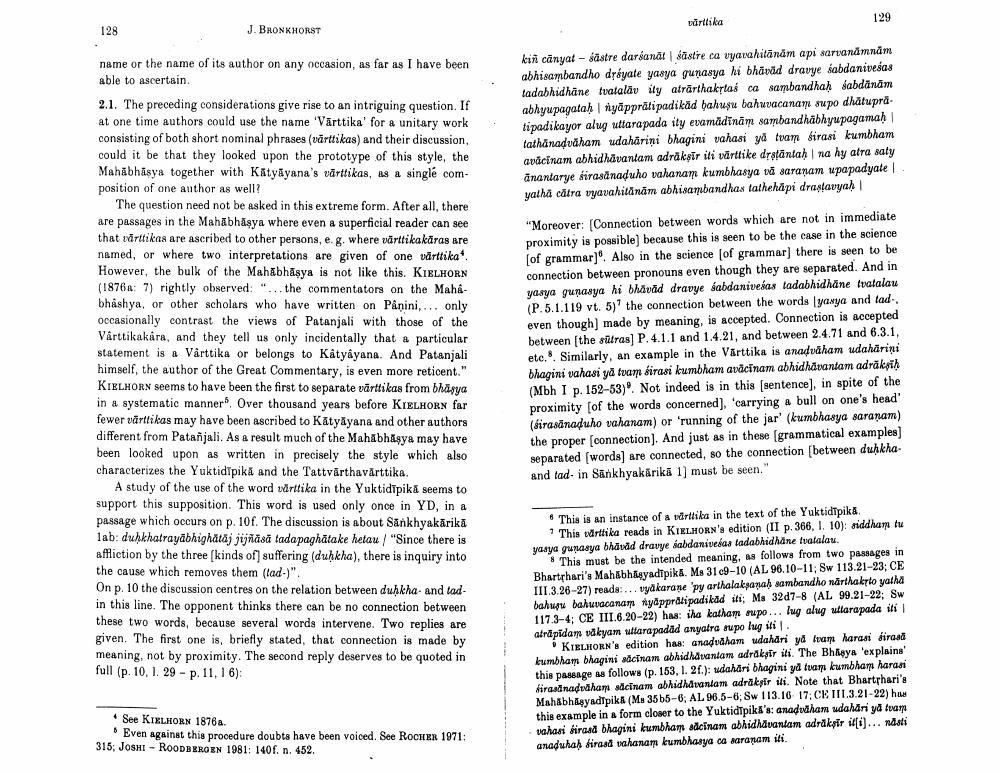Book Title: Archiv Fur Indische Philosophie Author(s): Johannes Bronkhorst Publisher: Johannes Bronkhorst View full book textPage 4
________________ 128 J. BRONKHORST name or the name of its author on any occasion, as far as I have been able to ascertain. 2.1. The preceding considerations give rise to an intriguing question. If at one time authors could use the name 'Varttika' for a unitary work consisting of both short nominal phrases (värttikas) and their discussion, could it be that they looked upon the prototype of this style, the Mahabhaṣya together with Katyayana's varttikas, as a single composition of one author as well? The question need not be asked in this extreme form. After all, there are passages in the Mahabhaṣya where even a superficial reader can see that värttikas are ascribed to other persons, e. g. where värttikakāras are named, or where two interpretations are given of one värttika. However, the bulk of the Mahabhaṣya is not like this. KIELHORN (1876a: 7) rightly observed: "... the commentators on the Mahabhashya, or other scholars who have written on Pânini,... only occasionally contrast the views of Patanjali with those of the Vârttikakára, and they tell us only incidentally that a particular. statement is a Vârttika or belongs to Kâtyâyana. And Patanjali himself, the author of the Great Commentary, is even more reticent." KIELHORN seems to have been the first to separate värttikas from bhasya in a systematic manner. Over thousand years before KIELHORN far fewer värttikas may have been ascribed to Kätyäyana and other authors different from Patanjali. As a result much of the Mahabhasya may have been looked upon as written in precisely the style which also characterizes the Yuktidipika and the Tattvärthavärttika. A study of the use of the word värttika in the Yuktidīpikä seems to support this supposition. This word is used only once in YD, in a passage which occurs on p. 10f. The discussion is about Sankhyakarikā lab: duḥkhatrayabhighätäj jijñāsä tadapaghatake hetau / "Since there is affliction by the three [kinds of] suffering (duḥkha), there is inquiry into the cause which removes them (tad-)". On p. 10 the discussion centres on the relation between duḥkha- and tadin this line. The opponent thinks there can be no connection between these two words, because several words intervene. Two replies are given. The first one is, briefly stated, that connection is made by meaning, not by proximity. The second reply deserves to be quoted in full (p. 10. 1. 29 p. 11, 16): See KIELHORN 1876a. Even against this procedure doubts have been voiced. See ROCHER 1971: 315; JOSHI ROODBERGEN 1981: 140f. n. 452. värtlika 129 - kin canyat - sastre darsanat | sastre ca vyavahitānām api sarvanämnäm abhisambandho dréyate yasya gunasya hi bhävad dravye sabdanivesas tadabhidhane tvatalav ity atrarthakṛtaś ca sambandhaḥ sabdānām abhyupagataḥ nyapprātipadikad bahuşu bahuvacanam supo dhätupratipadikayor alug uttarapada ity evamädīnām sambandhäbhyupagamaḥ | tathanaḍväham udaharini bhagini vahasi ya tvam sirasi kumbham avācinam abhidhävantam adräkṣir iti värttike dṛṣṭāntah na hy atra saty anantarye sirasanaḍuho vahanam kumbhasya va saranam upapadyate | yatha cātra vyavahitānām abhisambandhas tathehapi draṣṭavyaḥ | "Moreover: [Connection between words which are not in immediate proximity is possible] because this is seen to be the case in the science [of grammar]. Also in the science [of grammar] there is seen to be connection between pronouns even though they are separated. And in yasya gunasya hi bhavad dravye sabdanivesas tadabhidhane tvatalau (P.5.1.119 vt. 5) the connection between the words lyasya and tad-.. even though] made by meaning, is accepted. Connection is accepted between [the sutras] P. 4.1.1 and 1.4.21, and between 2.4.71 and 6.3.1, etc.. Similarly, an example in the Värttika is anaḍväham udahāriņi bhagini vahasi ya tvam birasi kumbham avacīnam abhidhävantam adrākṣiḥ (Mbh I p. 152-53). Not indeed is in this [sentence], in spite of the proximity [of the words concerned], 'carrying a bull on one's head' (birasanaḍuho vahanam) or 'running of the jar' (kumbhasya saranam) the proper [connection]. And just as in these [grammatical examples] separated [words] are connected, so the connection [between duḥkhaand tad- in Sankhyakärikä 1] must be seen." This is an instance of a varttika in the text of the Yuktidīpikā. 7 This värttika reads in KIELHORN's edition (II p. 366, 1. 10): siddham tu yasya gunasya bhavad dravye sabdanivetas tadabhidhäne tvatalau. 8 This must be the intended meaning, as follows from two passages in Bhartṛhari's Mahabhaṣуadīpika. Ms 31 c9-10 (AL 96.10-11; Sw 113.21-23; CE III.3.26-27) reads:... vyakarane 'py arthalakṣaṇaḥ sambandho narthakṛto yatha bahusu bahuvacanam nyapprälipadikad iti; Ms 32d7-8 (AL 99.21-22; Sw 117.3-4; CE III.6.20-22) has: iha katham supo... lug alug uttarapada iti | atrāpīdam vakyam uttarapadad anyatra supo lug iti. KIELHORN's edition has: anadväham udahāri ya tvam harasi sirasă kumbham bhagini sacīnam abhidhävantam adräkşir iti. The Bhagya 'explains' this passage as follows (p. 153, 1. 2f.): udahari bhagini ya tuam kumbham harasi firasanadväham sacīnam abhidhavaniam adräkşir iti. Note that Bhartṛhari's Mahabhasуadīpika (Ms 35 b5-6; AL 96.5-6; Sw 113.16 17; CE III.3.21-22) has this example in a form closer to the Yuktidīpika's: anadvaham udahari ya tvam vahasi sirasa bhagini kumbham sacīnam abhidhävantam adrākṣir it[i]... nästi anaduhaḥ birasa vahanam kumbhasya ca saranam iti.Page Navigation
1 2 3 4 5 6 7 8 9 10 11 12 13
